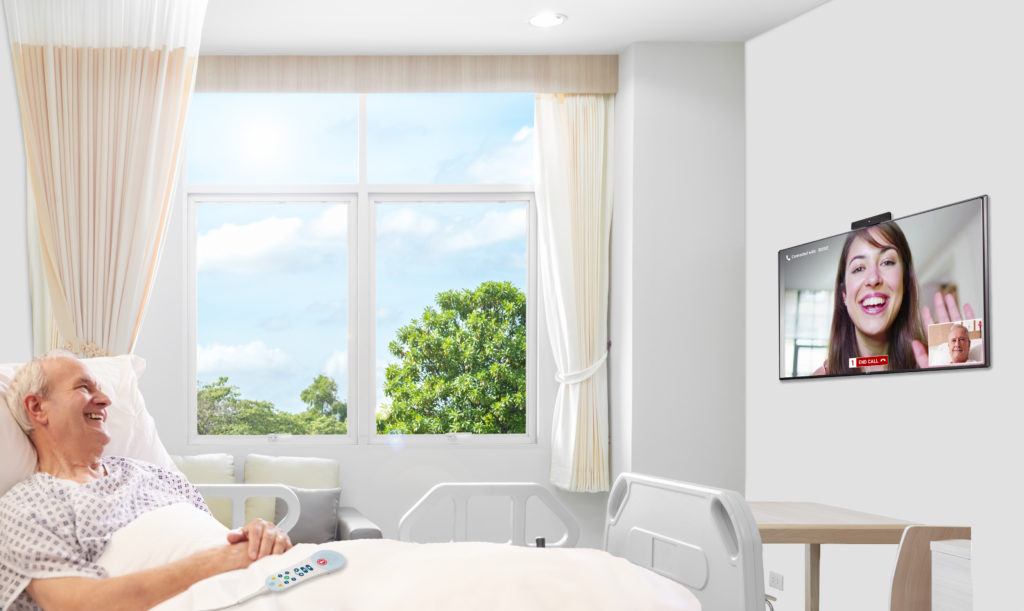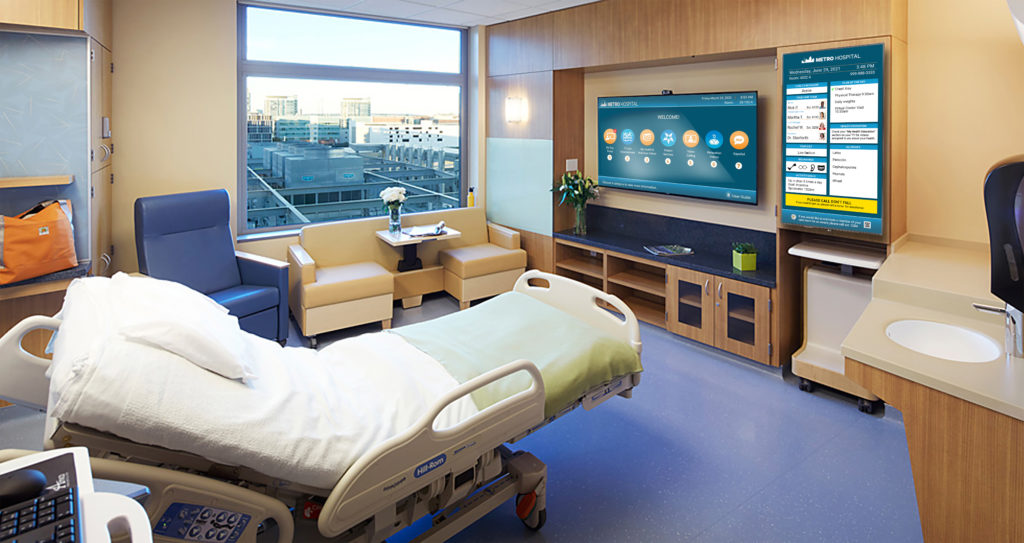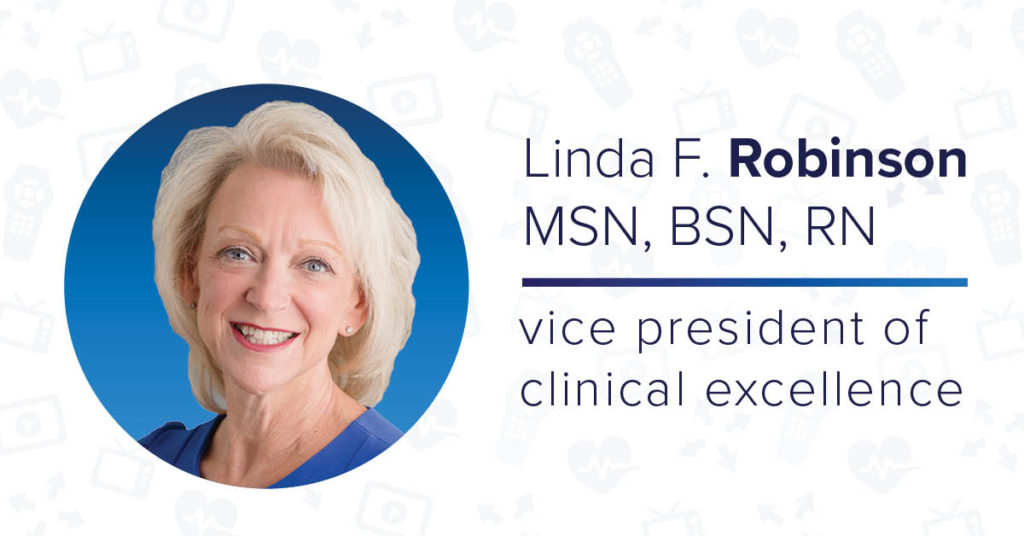
Hospitals today are using innovative patient engagement technology to elevate their patient experience. Recently we sat down with Linda Robinson, the Vice President of Clinical Excellence at MDM Healthcare to share some insights on the topic based on her 35 years of experience in nursing, patient- and family-centered care, and patient engagement technology. Robinson explained that there are several ways this technology supports hospitals in their quest to provide an exemplary patient experience. “Research tells us that patients want courtesy and the ability to participate in their care. Generally, there are three integrated areas to focus on when it comes to patient experience: quality, safety, and service,” she said. Robinson noted that many organizations use a framework of empathy to guide their patient experience strategies. She also stressed the importance of the four core principles outlined by The Institute of Patient and Family-Centered Care. These are respect and dignity, information sharing, participation, and collaboration.
Listening to patients' most pressing concerns is another way to ensure they will have a better day. Robinson addressed how patient engagement technology can solve a list of common patient complaints compiled by the Patient and Family Advisory Council at the Armstrong Institute for Patient Safety and Quality at Johns Hopkins.
Patient Complaint: Not Keeping the Whiteboard Updated
Patients want the whiteboards in their hospital rooms to be kept up to date. They want to be provided with the most current information about their care team and daily plan of care.
Journey PX’s digital whiteboard My Day, Today closes gaps in communication inside the hospital room. Robinson explained that manually updated information on a dry-erase board risks a lack of information transfer between shift changes. Digital whiteboards eliminate this problem, as vital information is always on display for patients inside their rooms. Robinson states, “Our digital whiteboard integrates with the hospital's EMR, which is so important because it provides up-to-date information. Patients and their families have a way to see what is going on even when a nurse cannot be in the room,” she said. Robinson also outlined some examples. “If a doctor orders an x-ray, that will show up on the My Day, Today screen as soon as it is ordered. Another scenario is if the patient gets prescribed a new medication, the system can automatically assign the patient education about it which focuses on purpose and side effects. Individualized relevant education videos will appear on their digital whiteboard and they will be prompted to watch it at their convenience,” she said.

Patient Complaint: Lack of Clear Communication
Patients and their families want open communication from their care teams. They want to be updated if there are any changes in their condition and informed of care delays.
Journey PX Connect enables video calling for patients and families. It also provides a secure connection that allows for virtual visits and rounding by hospital care teams, all through the TV in the patient’s room. “If there is something that needs to be communicated quickly, care teams can get in the room virtually. Our Connect solution increases the flow of communication, lets patients see their loved ones, and keep them updated on the status of their care,” said Robinson. She also mentioned that digital whiteboards are a huge asset when addressing any communication problems. My Day, Today displays pertinent health information in the patient’s room and connects with most hospitals’ EMRs, providing patients and their families with vital health information updated in real-time. “Having that information displayed and readily available to patients and their families is so wonderful. It makes such a dramatic difference to them,” she said.
Patient Complaint: Feeling Unengaged in Their Care
Patients want to be kept engaged in their care. They also want to make sure they understand their care plan, having health information provided to them in a language that is easy to understand.
Robinson explained how patient engagement technology addresses this concern. “Patients really do need to be involved in their daily plan of care. This supports the four core principles of patient and family-centered care. The patient is the captain of their care team, and Journey PX provides them with a variety of engagement tools in their room,” she said. She also explained that Journey PX is easy to use because it is intuitive. “There are buttons displayed on the patient’s television with categories and under each button is a number. To select their desired category, patients simply push the corresponding number on their pillow speaker, so it is quite easy to navigate,” she said. Simple, uncomplicated language is another aspect of Journey PX that really helps patients and their families. “Everything that goes up on the My Day, Today digital whiteboard is in a language that patients and families understand,” said Robinson. Patient engagement also drives quality, safety, and service. Journey PX My Stay includes an extensive education library that covers an extensive list of medical conditions and medications. This allows patients to become more empowered through health literacy.
Patient Complaint: Sleep and Noise Disturbances
Patients want hospital care teams to understand the importance of sleep for their recovery. They desire noise and other disturbances to be kept to a minimum during nighttime hours.
“We can see how providing an environment where a patient has a better quality of sleep is particularly important. Many hospitals have instituted programs to create healing environments for patients. Journey PX can prompt patients in the evening and let them know that their organization has a quiet at-night program,” said Robinson.
Another tool to improve patient sleep can be found inside the My Stay video library, which contains Medcalm’s calming videos for relaxation and meditation. This calming content has been proven to improve patients’ sleep.
My Stay also has a button on the home screen, My Service Requests, which can be customized to provide patients with a means of registering sleep and noise concerns right from their hospital bed.

Patient Complaint: Loss of Personal Belongings
Patients want hospitals to have a system to keep track of their personal items. Making sure patient’s property is accounted for supports the quality of their care.
My Day, Today helps keep track of patients’ belongings. “When staff logs patients’ valuables into the EMR, it displays that on the My Day, Today screen. It has that information readily available each day. This is an effective way of keeping track of this because oftentimes patients think they came in with certain items and they were mistaken. Again, it keeps that communication clear, improving their overall experience,” said Robinson.
Patient Complaint: Messy Rooms
Another simple, yet important desire patients have is for their rooms to be kept clean.
The My Service Request button allows patients to submit service requests right from their hospital beds. Once a service request is lodged it is sent to the appropriate department, such as EVS, to be addressed in a timely manner, and response times can be tracked to gauge efficiency. It is important to note that hospitals can customize the questions used in the My Service Request button for their organization. “It gives hospital organizations the ability to focus on areas they are working on, ensuring they are providing the best experience for their patients,” said Robinson. She explained why this ability is so valuable when it comes to improving patient experience. “When you think of service recovery, which is the ability to identify a problem, fix it, and recover that experience of the patient, it is important that you do that before they are discharged. It is not ideal for hospitals to have a patient go home only to receive their HCAHPS survey weeks later and be asked about room cleanliness,” she said.
Patient Complaint: Lack of Orientation to Their Room and the Hospital
Patients want basic hospital information such as how to work their television and order meals.
Hospitals with Journey PX display a welcome video for patients as soon as they turn on their television. Robinson explained that these videos are impactful because “they allow the hospital to introduce themselves, state their mission, vision, and values.” My Stay’s welcome videos walk patients and their families through orientation to their rooms. They also provide patients with essential information such as how to work their pillow speaker and control the Journey PX patient engagement solution on their television. In addition, they display information about rounding times. Robinson explained, “every organization does things a little bit differently, but everything can be displayed on the My Day, Today screen. So again, this is another example of how Journey PX drives information through a central place in the patient’s room, providing them valuable information even when staff cannot be with them.”

To hear more from Linda on the topic, listen to our full interview on our PX Space podcast.

